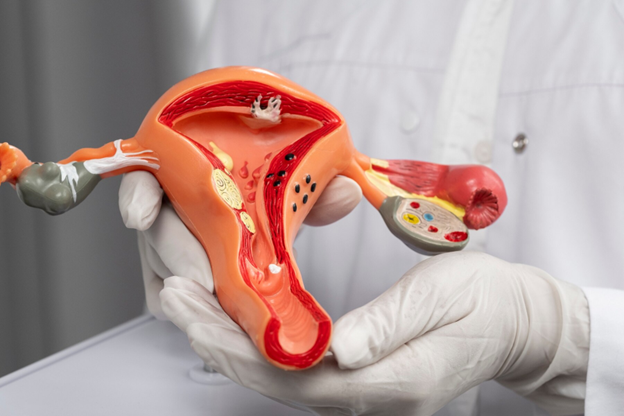Uterine fibroids are growths that appear in the uterus. Although non-cancerous, they can cause discomfort and various health issues. Understanding how to handle these fibroids is important for women's health.
Understanding Uterine Fibroids
Uterine fibroids, also known simply as fibroids, are non-cancerous growths in the uterus. They vary in size and number. Some women may have a single fibroid, while others have multiple. They are classified based on their location:
- Intramural fibroids: Found within the muscular wall of the uterus.
- Submucosal fibroids: Develop just under the lining of the uterine cavity.
- Subserosal fibroids: Found on the outer wall of the uterus.
Fibroids are most common among women of childbearing age. They affect up to 70% of women by age 50. Early detection through regular health check-ups is crucial. This helps manage symptoms and find suitable ways to handle fibroids. Recognizing fibroids early can prevent complications.
Identifying Symptoms and Causes
The symptoms of fibroids can vary. Some common signs include heavy periods, pelvic pain, and pressure in the abdomen. You may also experience frequent urination, constipation, or pain during sex. These symptoms can disrupt daily life, causing fatigue and discomfort.
The causes of fibroids are not entirely clear. However, hormones like estrogen seem to play a role in their growth. Factors that may increase your risk include:
- Age: Fibroids are more common as you age, especially during the 30s and 40s.
- Ethnicity: African American women experience fibroids more frequently than other groups.
- Family history: If your mother or sister had fibroids, you might be at higher risk.
Understanding these risks can help with the uterine fibroids course of action to be taken for managing symptoms effectively.
Diagnostic Approaches for Uterine Fibroids
Diagnosing fibroids is vital for effective treatment. Doctors use various tools to identify fibroids, such as ultrasound and MRI scans. These imaging tools help visualize fibroid size and location. Hysteroscopy, where a small camera is inserted into the uterus, is also useful.
Every woman's situation is different. That’s why a personalized diagnosis is important. This ensures that the right uterine fibroids course of action to be taken is selected. It helps tailor treatment to specific needs, improving results and quality of life.
Non-Surgical Treatment: Lifestyle Management and Self-Care
Lifestyle changes can be part of managing fibroids without surgery. Adjusting your diet is one effective strategy. Focus on foods rich in vitamins, fiber, and low-fat dairy.
- Include: Green leafy vegetables, fruits, seeds, and whole grains.
- Avoid: Red meats and high-calorie junk foods.
Physical activity helps reduce symptoms, especially when coupled with stress management through techniques like yoga or meditation. Some women find relief with fibroids natural remedies like using herbs or oils. These practices are seen as natural cures for fibroids by promoting balance in the body.
Self-care routines can include:
- Complementary therapies like acupuncture.
- Maintaining a healthy weight.
- Monitoring any changes in symptoms.
These natural ways to cure fibroids often work alongside medical advice to better manage symptoms at home.
Medical Treatments: Hormonal and Minimally Invasive Options
When lifestyle adjustments aren't enough, medical treatments are available. Hormonal therapies help manage fibroid growth by regulating hormone levels. These treatments can alleviate symptoms and reduce fibroid size.
Minimally invasive procedures are another uterine fibroids treatment option. Uterine artery embolization is one such option. This procedure blocks blood supply to fibroids, making them shrink. It’s less invasive and offers quick recovery.
Laparoscopic myomectomy involves small incisions, allowing for fibroid removal without major surgery. These methods are effective for many women seeking relief with minimal downtime.
Exploring Surgical Options for Severe Fibroids
In more severe cases, surgery might be necessary. Myomectomy is a procedure to remove fibroids, preserving the uterus if future pregnancies are planned. A hysterectomy, removing the uterus, is considered when fibroids cause significant issues and other treatments fail.
These surgeries may impact future fertility. Discussing options with a doctor fully is important for informed decisions. Success stories show improvement in life quality for those opting for surgery.
Complications and Long-Term Management
While treatments are effective, complications can arise. Monitoring for issues like infection and following recovery guidelines is crucial. Long-term management involves adjustments to lifestyle and regular check-ups to prevent regrowth or new fibroids.
Healthy habits include a balanced diet, regular exercise, and stress reduction. Staying proactive about health can minimize symptoms and improve wellbeing.
Conclusion
Managing uterine fibroids involves a comprehensive approach that encompasses lifestyle modifications and advanced medical interventions. It’s crucial to understand the various strategies available to effectively address uterine fibroids. Staying informed and proactive is essential for improving symptoms and enhancing your quality of life. For expert guidance and personalized treatment options, consider visiting Dr. Swathi's Women's Clinic, where you can receive specialized care tailored to your needs. Take charge of your health today and make informed decisions about managing uterine fibroids.



